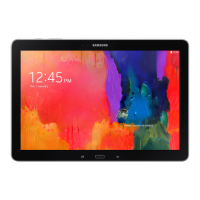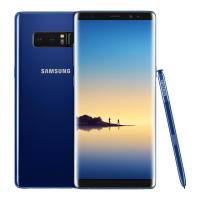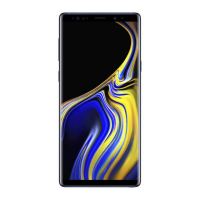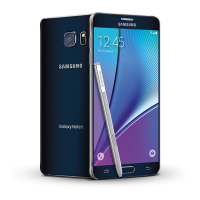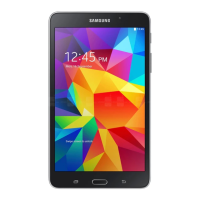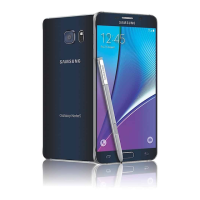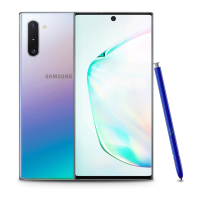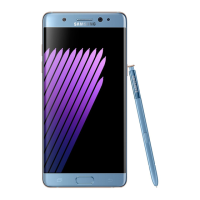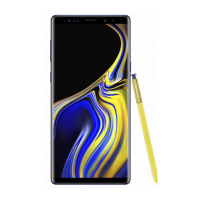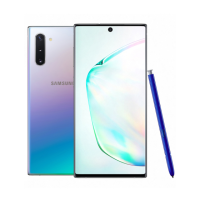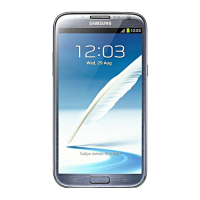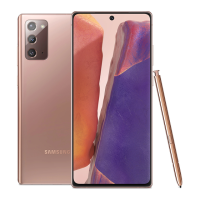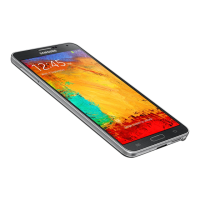
Do you have a question about the Samsung GALAXY Note3 and is the answer not in the manual?
| Display | 5.7 inches, Super AMOLED, 1080 x 1920 pixels |
|---|---|
| RAM | 3 GB |
| Internal Storage | 32/64 GB |
| Expandable Storage | microSD, up to 64 GB |
| Front Camera | 2 MP, f/2.4, 27mm (wide) |
| Battery | Li-Ion 3200 mAh, removable |
| Operating System | Android 4.3 (Jelly Bean), upgradable to 5.0 (Lollipop) |
| Weight | 168 g (5.93 oz) |
| Dimensions | 151.2 x 79.2 x 8.3 mm (5.95 x 3.12 x 0.33 in) |
| SIM | Micro-SIM |
| Network | GSM / HSPA / LTE |
| Announced | 2013, September |
| Status | Discontinued |
| Technology | GSM / HSPA / LTE |
| 2G bands | GSM 850 / 900 / 1800 / 1900 |
| 3G bands | HSDPA 850 / 900 / 1900 / 2100 |
| Speed | HSPA 42.2/5.76 Mbps, LTE Cat4 150/50 Mbps |
| GPRS | Yes |
| EDGE | Yes |
| Protection | Corning Gorilla Glass 3 |
| Multitouch | Yes |
| Alert types | Vibration; MP3, WAV ringtones |
| Loudspeaker | Yes |
| 3.5mm jack | Yes |
| WLAN | Wi-Fi 802.11 a/b/g/n/ac, dual-band, Wi-Fi Direct, DLNA, hotspot |
| Bluetooth | 4.0, A2DP, LE, aptX |
| GPS | Yes, with A-GPS, GLONASS |
| NFC | Yes |
| Infrared port | Yes |
| Radio | No |
| USB | microUSB 3.0 (MHL 2), USB Host |
| Messaging | SMS(threaded view), MMS, Email, Push Mail, IM |
| Browser | HTML5 |
| Java | Yes, via Java MIDP emulator |
| Talk time | Up to 21 h (3G) |
| Processor | Quad-core 2.3 GHz Krait 400 (N9005)/ Quad-core 1.9 GHz Cortex-A15 & quad-core 1.3 GHz Cortex-A7 (N9000) |
| Main Camera | 13 MP, f/2.2, 31mm (standard), AF |
| Colors | Black, White, Pink, Rose Gold Black, Rose Gold White |
| 4G bands | LTE band 1(2100), 3(1800), 5(850), 7(2600), 8(900), 20(800) |
| Chipset | Qualcomm Snapdragon 800 / Exynos 5420 Octa |
| GPU | Adreno 330 / Mali-T628 MP6 |
| Sensors | Accelerometer, gyro, proximity, compass, barometer, temperature, humidity, gesture |
Information about incorporating open source software components under various public licenses.
Samsung's liability exclusion for performance issues caused by software modifications.
Samsung entities disclaim all warranties for IT security protection, SAFE™ devices, and applications.
Guides initial setup, including battery and SIM card installation.
Instructions for charging the device's battery using the provided travel charger.
Steps to power the device on and off using the power button.
Procedures for securing and accessing the device's screen using swipe gestures.
Walkthrough for initial phone setup and configuration, including language selection.
Steps to create a Samsung account for accessing services like ChatON and Samsung Hub.
Guide to setting up a Google account for device integration and app synchronization.
Instructions for configuring voicemail service, including password and greeting.
An overview of the phone's key capabilities and specifications.
Detailed diagram and description of the phone's front panel components.
Diagram and description of the phone's side panel components.
Diagram and description of the phone's rear panel components.
Information on the S Pen stylus, its functions, and handling.
Explains the meaning of various status icons displayed on the phone's screen.
Instructions on how to dial numbers and initiate calls using the keypad.
How to make emergency calls, with or without a SIM card installed.
How to set up and use speed dial for quick calling.
How to answer or reject incoming calls and send message responses.
Information on viewing and managing call history, including missed and recent calls.
Features available during an active call like hold, add call, keypad, end call, and speaker.
Accessing and configuring various call-related settings.
Steps to activate and synchronize contacts with the AT&T Address Book service.
Procedure for adding new contacts to the address book, including photo and details.
How to search and locate contacts within the address book using various methods.
How to merge multiple contact entries into a single record for easier management.
Managing contact groups, including adding and removing contacts.
Basic steps for capturing photos with the device camera, including zoom and focus.
How to take photos using both front and rear cameras simultaneously.
Explanation of different camera modes for optimizing photo quality.
Using the built-in editor to adjust brightness, contrast, color, and apply effects.
How to record, view, and send videos using the phone's camera.
Viewing photos and videos, and performing basic editing tasks.
How to navigate to the main settings menu and its different tabs.
How to activate and manage Wi-Fi connections, including Wi-Fi Direct.
Setting up device name, visibility, and pairing for Bluetooth devices.
Sharing the phone's mobile data connection via USB or Wi-Fi hotspot.
How to enable Airplane mode to disable wireless communications.
How to view and manage mobile data usage and set data limits.
Settings for determining phone location and sensor configurations.
Steps to set up and manage Virtual Private Network connections.
How to enable Near Field Communication for data exchange between devices.
Adjusting volume, vibration intensity, ringtones, and notification sounds.
Adjusting screen brightness, timeout, color modes, and daydream settings.
Choosing and setting up screen lock methods like Swipe, PIN, or Pattern.
Feature for running multiple applications simultaneously on the screen.
Managing LED lights for charging, notifications, and voice recording.
Enabling a simplified interface for first-time smartphone users.
Features to make the device easier to use for users with disabilities.
Changing the keyboard used by the device and configuring input methods.
Setting up voice commands to control device operations like calls and music.
Enabling automatic reading of incoming calls and notifications.
Customizing S Pen features like pen detection and detachment options.
Adjusting interface elements for easier use with one hand.
Setting up various motion activation services for device control.
Steps to set up, manage, and synchronize Google and email accounts.
Options for backing up data, accounts, and resetting the phone to factory defaults.
Settings to manage device security, including unknown sources and verification.
Overview of supported message types like Text, MMS, Email, and Hangouts.
Steps to compose and send text and multimedia messages.
Options available before message composition, like search and delete threads.
Steps to delete individual message threads or multiple threads.
How to search for specific messages using keywords.
Configuring settings for text, MMS, voice, and push messages.
Explanation of Wi-Fi technology and how to connect to networks.
Steps to enable Wi-Fi to discover and connect to compatible networks.
Enabling direct device-to-device connections for large data transfers.
Setting up device name, visibility, and pairing for Bluetooth devices.
Connecting the device to a PC using various USB connection modes.
Connecting the device as a removable disk or memory card reader.
Activating USB 3.0 connectivity mode for faster data transfer.
Explains application icons for quick access in the Apps menu.
Creating memos and linking them to actions like calls or messages.
Scanning barcodes for product information and online access.
Setting up auto-reply and contact preferences for driving mode.
Locating family members and managing location information.
Storing, sharing, and syncing photos, videos, and documents.
Accessing real-time GPS navigation and local search services.
Using the phone as a calculator with basic arithmetic functions and history.
How to view the calendar by day, week, or month, and create events.
Using the 13MP camera for photos and videos.
Global mobile communication service for chatting with friends.
Using the Google Chrome web browser on the phone.
Accessing alarms, world clock, stopwatch, and timer functions.
Setting alarms with options for time, repeat, type, tone, volume, and location.
Managing contacts, synchronizing with AT&T Address Book, and device help.
Reviewing and creating emails using various email services.
Viewing photos and videos, and performing basic editing tasks.
Using the Google Search application and configuring Google settings.
Sharing media with friends in real-time by creating or joining groups.
Google's instant messaging application for conversations and video calls.
Bringing groups of friends together for simple conversations.
Managing texts, calls, and voicemail messages.
Scanning barcodes for product information and online access.
Setting up auto-reply and contact preferences for driving mode.
Locating family members and managing location information.
Storing, sharing, and syncing photos, videos, and documents.
Accessing real-time GPS navigation and local search services.
Using the phone as a calculator with basic arithmetic functions and history.
How to view the calendar by day, week, or month, and create events.
Setting alarms with options for time, repeat, type, tone, volume, and location.
Information regarding RF exposure from wireless phones and potential health effects.
Summarizes research findings on the link between RF exposure and health issues.
Steps to minimize RF exposure using hands-free kits and other accessories.
Safety advice for children using cell phones and RF exposure considerations.
Details on SAR limits and certification information for wireless phones.
User information regarding FCC compliance and potential interference.
Device capabilities for receiving wireless emergency alerts.
Guidelines for responsible mobile device use while operating a vehicle.
Important guidelines for handling and storing batteries to prevent injury or damage.
Cautionary advice to avoid potential hearing loss from loud sounds.
Information on wireless device compatibility with hearing aids.
Notices regarding device modifications, approved accessories, and handling.
Safety precautions for servicing, vehicle installation, aircraft use, and eye strain.
Details on what is covered, warranty periods for phone, batteries, and accessories.
Exclusions from the limited warranty, including accidental damage and misuse.
Samsung's responsibilities for repair or replacement of defective products.
Steps required to obtain warranty service, including returning the product.
Limitations on Samsung's liability regarding product defects and third-party software.
Samsung grants rights for software use, installation, and backup.
Samsung reserves all rights not expressly granted for the software.
Restrictions on reverse engineering, modification, and distribution of the software.
Information on receiving security updates and software enhancements.
Procedure for resolving disputes through arbitration for US and non-US residents.
Customize your Samsung device experience by activating warranty and accessing account.
Access latest info on promotions, events, and product reviews.
